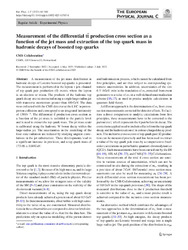Measurement of the differential t t ¯production cross section as a function of the jet mass and extraction of the top quark mass in hadronic decays of boosted top quarks
| dc.contributor.author | Tumasyan, A. | |
| dc.contributor.author | Işıldak, Bora | |
| dc.date.accessioned | 2024-02-22T05:31:50Z | |
| dc.date.available | 2024-02-22T05:31:50Z | |
| dc.date.issued | 2023-07-03 | |
| dc.identifier.issn | 1434-6044 | en_US |
| dc.identifier.uri | http://hdl.handle.net/10679/9197 | |
| dc.identifier.uri | https://link.springer.com/article/10.1140/epjc/s10052-023-11587-8 | |
| dc.description.abstract | A measurement of the jet mass distribution in hadronic decays of Lorentz-boosted top quarks is presented. The measurement is performed in the lepton + jets channel of top quark pair production (t t ¯) events, where the lepton is an electron or muon. The products of the hadronic top quark decay are reconstructed using a single large-radius jet with transverse momentum greater than 400 GeV . The data were collected with the CMS detector at the LHC in proton-proton collisions and correspond to an integrated luminosity of 138 fb-1 . The differential t t ¯ production cross section as a function of the jet mass is unfolded to the particle level and is used to extract the top quark mass. The jet mass scale is calibrated using the hadronic W boson decay within the large-radius jet. The uncertainties in the modelling of the final state radiation are reduced by studying angular correlations in the jet substructure. These developments lead to a significant increase in precision, and a top quark mass of 173.06±0.84GeV . | en_US |
| dc.description.sponsorship | BMBWF and FWF (Austria); FNRS and FWO (Belgium); CNPq, CAPES, FAPERJ, FAPERGS, and FAPESP (Brazil); MES and BNSF (Bulgaria); CERN; CAS, MoST, and NSFC (China); MINCIENCIAS (Colombia); MSES and CSF (Croatia); RIF (Cyprus); SENESCYT (Ecuador); MoER, ERC PUT and ERDF (Estonia); Academy of Finland, MEC, and HIP (Finland); CEA and CNRS/IN2P3 (France); BMBF, DFG, and HGF (Germany); GSRI (Greece); NKFIH (Hungary); DAE and DST (India); IPM (Iran); SFI (Ireland); INFN (Italy); MSIP and NRF (Republic of Korea); MES (Latvia); LAS (Lithuania); MOE and UM (Malaysia); BUAP, CINVESTAV, CONACYT, LNS, SEP, and UASLP-FAI (Mexico); MOS (Montenegro); MBIE (New Zealand); PAEC (Pakistan); MES and NSC (Poland); FCT (Portugal); MESTD (Serbia); MCIN/AEI and PCTI (Spain); MOSTR (Sri Lanka); Swiss Funding Agencies (Switzerland); MST (Taipei); MHESI and NSTDA (Thailand); TUBITAK and TENMAK (Turkey); NASU (Ukraine); STFC (UnitedKingdom); DOE andNSF (USA). Individuals have received support from the Marie-Curie programme and the European Research Council and Horizon 2020 Grant, contract Nos. 675440, 724704, 752730, 758316, 765710, 824093, 884104, and COST Action CA16108 (European Union); the Leventis Foundation; the Alfred P. Sloan Foundation; the Alexander von Humboldt Foundation; the Belgian Federal Science Policy Office; the Fonds pour la Formation a la Recherche dans l'Industrie et dans l'Agriculture (FRIA-Belgium); the Agentschap voor Innovatie doorWetenschap en Technologie (IWT-Belgium); the F.R.S.-FNRS and FWO (Belgium) under the "Excellence of Science -EOS" -be.h project n. 30820817; the Beijing Municipal Science& Technology Commission, No. Z191100007219010; theMinistry of Education, Youth and Sports (MEYS) of theCzech Republic; the Hellenic Foundation forResearch and Innovation (HFRI), Project Number 2288 (Greece); the Deutsche Forschungsgemeinschaft (DFG), under Germany's Excellence Strategy -EXC 2121 "Quantum Universe" 390833306, and under project number 400140256 -GRK2497; theHungarian Academy of Sciences, the New National Excellence Program UNKP, the NKFIH research grants K 124845, K 124850, K 128713, K 128786, K 129058, K 131991, K 133046, K 138136, K 143460, K 143477, 2020-2.2.1-ED-2021-00181, and TKP2021-NKTA-64 (Hungary); theCouncil of Science and IndustrialResearch, India; the Latvian Council of Science; the Ministry of Education and Science, project no. 2022/WK/14, and the National Science Center, contracts Opus 2021/41/B/ST2/01369 and 2021/43/B/ST2/01552 (Poland); the Fundacao para a Ciencia e a Tecnologia, grant CEECIND/01334/2018 (Portugal); the National Priorities Research Program by Qatar National Research Fund; MCIN/AEI/10. r 13039/501100011033, ERDF "a way of making Europe", and the Programa Estatal de Fomento de la Investigacion Cientifica y Tecnica de Excelencia Maria de Maeztu, grant MDM-2017-0765 and Programa Severo Ochoa del Principado de Asturias (Spain); the Chulalongkorn Academic into Its 2nd Century Project Advancement Project, and the National Science, Research and Innovation Fund via the Program Management Unit for Human Resources& InstitutionalDevelopment, Research and Innovation, grant B05F650021 (Thailand); the Kavli Foundation; theNvidiaCorporation; the SuperMicro Corporation; the Welch Foundation, contract C-1845; and the Weston Havens Foundation (USA). | |
| dc.language.iso | eng | en_US |
| dc.publisher | Springer | en_US |
| dc.relation.ispartof | European Physical Journal C | |
| dc.rights | openAccess | |
| dc.rights | Attribution 4.0 International | |
| dc.rights.uri | https://creativecommons.org/licenses/by/4.0/ | |
| dc.title | Measurement of the differential t t ¯production cross section as a function of the jet mass and extraction of the top quark mass in hadronic decays of boosted top quarks | en_US |
| dc.type | Article | en_US |
| dc.description.version | Publisher version | en_US |
| dc.peerreviewed | yes | en_US |
| dc.publicationstatus | Published | en_US |
| dc.contributor.department | Özyeğin University | |
| dc.contributor.authorID | (ORCID 0000-0002-0283-5234 & YÖK ID 124605) Işıldak, Bora | |
| dc.contributor.ozuauthor | Işıldak, Bora | |
| dc.creator | The CMS Collaboration | |
| dc.identifier.volume | 83 | en_US |
| dc.identifier.issue | 7 | en_US |
| dc.identifier.wos | WOS:001062453000001 | |
| dc.identifier.doi | 10.1140/epjc/s10052-023-11587-8 | en_US |
| dc.identifier.scopus | SCOPUS:2-s2.0-85182479382 | |
| dc.relation.publicationcategory | Article - International Refereed Journal - Institutional Academic Staff |
Files in this item
This item appears in the following Collection(s)
Share this page




